- Home
- Mary Roach
Stiff Page 5
Stiff Read online
Page 5
Imperial Rome gives us another nice example of what happens to medicine when the government frowns on human dissection. Galen, one of history’s most revered anatomists, whose texts went unchallenged for centuries, never once dissected a human cadaver. In his post as surgeon to the gladiators, he had a frequent, if piecemeal, window on the human interior in the form of gaping sword wounds and lion claw lacerations. He also dissected a good sum of animals, preferably apes, which he believed to be anatomically identical to humans, especially, he maintained, if the ape had a round face. The great Renaissance anatomist Vesalius later pointed out that there are two hundred anatomical differences between apes and humans in skeletal structure alone. (Whatever Galen’s shortcomings as a comparative anatomist, the man is to be respected for his ingenuity, for procuring apes in ancient Rome can’t have been easy.) He got a lot right, it’s just that he also got a fair amount wrong. His drawings showed five-lobed livers and hearts with three ventricles.
The ancient Greeks were similarly adrift when it came to human anatomy. Like Galen, Hippocrates never dissected a human cadaver—he called dissection “unpleasant if not cruel.” According to the book Early History of Human Anatomy, Hippocrates referred to tendons as “nerves” and believed the human brain to be a mucus-secreting gland. Though I found this information surprising, this being the Father of Medicine we are talking about, I did not question it. You do not question an author who appears on the title page as “T.V.N. Persaud, M.D., Ph.D., D.Sc., F.R.C. Path. (Lond.), F.F. Path. (R.C.P.I.), F.A.C.O.G.” Who knows, perhaps history erred in bestowing upon Hippocrates the title Father of Medicine. Perhaps T.V.N. Persaud is the Father of Medicine.
It’s no coincidence that the man who contributed the most to the study of human anatomy, the Belgian Andreas Vesalius, was an avid proponent of do-it-yourself, get-your-fussy-Renaissance-shirt-dirty anatomical dissection. Though human dissection was an accepted practice in the Renaissance-era anatomy class, most professors shied away from personally undertaking it, preferring to deliver their lectures while seated in raised chairs a safe and tidy remove from the corpse and pointing out structures with a wooden stick while a hired hand did the slicing. Vesalius disapproved of this practice, and wasn’t shy about his feelings. In C. D. O’Malley’s biography of the man, Vesalius likens the lecturers to “jackdaws aloft in their high chair, with egregious arrogance croaking things they have never investigated but merely committed to memory from the books of others. Thus everything is wrongly taught,…and days are wasted in ridiculous questions.”
Vesalius was a dissector such as history had never seen. This was a man who encouraged his students to “observe the tendons while dining on any animal.” While studying medicine in Belgium, he not only dissected the corpses of executed criminals but snatched them from the gibbet himself.
Vesalius produced a series of richly detailed anatomical plates and text called De Humani Corporis Fabrica, the most venerated anatomy book in history. The question then becomes, was it necessary, once the likes of Vesalius had pretty much figured out the basics, for every student of anatomy to get right in there and figure them out all over again? Why couldn’t models and preserved prosections be used to teach anatomy? Do gross anatomy labs reinvent the wheel? The questions were especially relevant in Knox’s day, given the way in which bodies were procured, but they are still relevant today.
I asked Hugh Patterson about this and learned that, in fact, whole-cadaver dissection is being phased out at some medical schools. Indeed, the gross anatomy course I visited at UCSF was the last one in which students will dissect entire cadavers. Beginning the following semester, they would be studying prosections—embalmed sections of the body cut and prepared so as to display key anatomical features and systems. Over at the University of Colorado, the Center for Human Simulation is leading the charge toward digital anatomy instruction. In 1993, they froze a cadaver and sanded off a millimeter cross section at a time, photographing each new view—1,871 in all—to create an on-screen, maneuverable 3-D rendition of the man and all his parts, a sort of flight simulator for students of anatomy and surgery.
The changes in the teaching of anatomy have nothing to do with cadaver shortages or public opinion about dissection; they have everything to do with time. Despite the immeasurable advances made in medicine over the past century, the material must be covered in the same number of years. Suffice it to say there’s a lot less time for dissection than there was in Astley Cooper’s day.
I asked the students in Patterson’s gross anatomy lab how they’d feel if they hadn’t had a chance to dissect a body. While some said they would feel cheated—that the gross anatomy cadaver experience was a physician’s rite of passage—many expressed approval. “There were days,” said one, “when it all clicked and I gained a sort of understanding I could never have gotten from a book. But there were other days, a lot of days, when coming up here and spending two hours felt like a huge waste of time.”
But gross anatomy lab is not just about learning anatomy. It is about confronting death. Gross anatomy provides the medical student with what is very often his or her first exposure to a dead body; as such, it has long been considered a vital, necessary step in the doctor’s education. But what was learned, up until quite recently, was not respect and sensitivity, but the opposite. The traditional gross anatomy lab represented a sort of sink-or-swim mentality about dealing with death. To cope with what was being asked of them, medical students had to find ways to desensitize themselves. They quickly learned to objectify cadavers, to think of the dead as structures and tissues, and not a former human being. Humor—at the cadaver’s expense—was tolerated, condoned even. “There was a time not all that long ago,” says Art Dalley, director of the Medical Anatomy Program at Vanderbilt University, “when students were taught to be insensitive, as a coping mechanism.”
Modern educators feel there are better, more direct ways to address death than handing students a scalpel and assigning them a corpse. In Patterson’s anatomy class at UCSF, as in many others, some of the time saved by eliminating full-body dissection will be devoted to a special unit on death and dying. If you’re going to bring in an outsider to teach students about death, a hospice patient or grief counselor surely has as much to offer as a dead man does.
If the trend continues, medicine may find itself with something unimaginable two centuries ago: a surplus of cadavers. It is remarkable how deeply and how quickly public opinion regarding dissection and body donation has come around. I asked Art Dalley what accounted for the change. He cited a combination of factors. The 1960s saw the first heart transplant and the passing of the Uniform Anatomical Gift Act, both of which raised awareness of the need for organs for transplantation and of body donation as an option. Around the same time, Dalley says, there was a notable increase in the cost of funerals. This was followed by the publication of The American Way of Death—Jessica Mitford’s biting exposé of the funeral industry—and a sudden upswing in the popularity of cremation. Willing one’s body to science began to be seen as another acceptable—and, in this case, altruistic—alternative to burial.
To those factors I would add the popularization of science. The gains in the average person’s understanding of biology have, I imagine, worked to dissolve the romance of death and burial—the lingering notion of the cadaver as some beatific being in an otherworldly realm of satin and chorale music, the well-groomed almost-human who simply likes to sleep a lot, underground, in his clothing. The people of the 1800s seemed to feel that burial culminated in a fate less ghastly than that of dissection. But that, as we’ll see, is hardly the case.
3
LIFE AFTER DEATH
On human decay and what can be done about it
Out behind the University of Tennessee Medical Center is a lovely, forested grove with squirrels leaping in the branches of hickory trees and birds calling and patches of green grass where people lie on their backs in the sun, or sometimes the shade, depending on where the researchers put them.
/> This pleasant Knoxville hillside is a field research facility, the only one in the world dedicated to the study of human decay. The people lying in the sun are dead. They are donated cadavers, helping, in their mute, fragrant way, to advance the science of criminal forensics. For the more you know about how dead bodies decay—the biological and chemical phases they go through, how long each phase lasts, how the environment affects these phases—the better equipped you are to figure out when any given body died: in other words, the day and even the approximate time of day it was murdered. The police are pretty good at pinpointing approximate time of death in recently dispatched bodies. The potassium level of the gel inside the eyes is helpful during the first twenty-four hours, as is algor mortis—the cooling of a dead body; barring temperature extremes, corpses lose about 1.5 degrees Fahrenheit per hour until they reach the temperature of the air around them. (Rigor mortis is more variable: It starts a few hours after death, usually in the head and neck, and continues, moving on down the body, finishing up and disappearing anywhere from ten to forty-eight hours after death.)
If a body has been dead longer than three days, investigators turn to entomological clues (e.g., how old are these fly larvae?) and stages of decay for their answers. And decay is highly dependent on environmental and situational factors. What’s the weather been like? Was the body buried? In what? Seeking better understanding of the effects of these factors, the University of Tennessee (UT) Anthropological Research Facility, as it is blandly and vaguely called, has buried bodies in shallow graves, encased them in concrete, left them in car trunks and manmade ponds, and wrapped them in plastic bags. Pretty much anything a killer might do to dispose of a dead body the researchers at UT have done also.
To understand how these variables affect the time line of decomposition, you must be intimately acquainted with your control scenario: basic, unadulterated human decay. That’s why I’m here. That’s what I want to know: When you let nature take its course, just exactly what course does it take?
My guide to the world of human disassembly is a patient, amiable man named Arpad Vass. Vass has studied the science of human decomposition for more than a decade. He is an adjunct research professor of forensic anthropology at UT and a senior staff scientist at the nearby Oak Ridge National Laboratory. One of Arpad’s projects at ORNL has been to develop a method of pinpointing time of death by analyzing tissue samples from the victim’s organs and measuring the amounts of dozens of different time-dependent decay chemicals. This profile of decay chemicals is then matched against the typical profiles for that tissue for each passing postmortem hour. In test runs, Arpad’s method has determined the time of death to within plus or minus twelve hours.
The samples he used to establish the various chemical breakdown time lines came from bodies at the decay facility. Eighteen bodies, some seven hundred samples in all. It was an unspeakable task, particularly in the later stages of decomposition, and particularly for certain organs. “We’d have to roll the bodies over to get at the liver,” recalls Arpad. The brain he got to using a probe through the eye orbit. Interestingly, neither of these activities was responsible for Arpad’s closest brush with on-the-job regurgitation. “One day last summer,” he says weakly, “I inhaled a fly. I could feel it buzzing down my throat.”
I have asked Arpad what it’s like to do this sort of work. “What do you mean?” he asked me back. “You want a vivid description of what’s going through my brain as I’m cutting through a liver and all these larvae are spilling out all over me and juice pops out of the intestines?” I kind of did, but I kept quiet. He went on: “I don’t really focus on that. I try to focus on the value of the work. It takes the edge off the grotesqueness.” As for the humanness of his specimens, that no longer disturbs him. Though it once did. He used to lay the bodies on their stomachs so he didn’t have to see their faces.
This morning, Arpad and I are riding in the back of a van being driven by the lovable and agreeable Ron Walli, one of ORNL’s media relations guys. Ron pulls into a row of parking spaces at the far end of the UT Medical Center lot, labeled G section. On hot summer days, you can always find a parking space in G section, and not just because it’s a longer walk to the hospital. G section is bordered by a tall wooden fence topped with concertina wire, and on the other side of the fence are the bodies. Arpad steps down from the van. “Smell’s not that bad today,” he says. His “not that bad” has that hollow, over-upbeat tone one hears when spouses back over flowerbeds or home hair coloring goes awry.
Ron, who began the trip in a chipper mood, happily pointing out landmarks and singing along with the radio, has the look of a condemned man. Arpad sticks his head in the window. “Are you coming in, Ron, or are you going to hide in the car again?” Ron steps out and glumly follows. Although this is his fourth time in, he says he’ll never get used to it. It’s not the fact that they’re dead—Ron saw accident victims routinely in his former post as a newspaper reporter—it’s the sights and smells of decay. “The smell just stays with you,” he says. “Or that’s what you imagine. I must have washed my hands and face twenty times after I got back from my first time out here.”
Just inside the gate are two old-fashioned metal mailboxes on posts, as though some of the residents had managed to convince the postal service that death, like rain or sleet or hail, should not stay the regular delivery of the U.S. Mail. Arpad opens one and pulls turquoise rubber surgical gloves from a box, two for him and two for me. He knows not to offer them to Ron.
“Let’s start over there.” Arpad is pointing to a large male figure about twenty feet distant. From this distance, he could be napping, though there is something in the lay of the arms and the stillness of him that suggests something more permanent. We walk toward the man. Ron stays near the gate, feigning interest in the construction details of a toolshed.
Like many big-bellied people in Tennessee, the dead man is dressed for comfort. He wears gray sweatpants and a single-pocket white T-shirt. Arpad explains that one of the graduate students is studying the effects of clothing on the decay process. Normally, they are naked.
The cadaver in the sweatpants is the newest arrival. He will be our poster man for the first stage of human decay, the “fresh” stage. (“Fresh,” as in fresh fish, not fresh air. As in recently dead but not necessarily something you want to put your nose right up to.) The hallmark of fresh-stage decay is a process called autolysis, or self-digestion. Human cells use enzymes to cleave molecules, breaking compounds down into things they can use. While a person is alive, the cells keep these enzymes in check, preventing them from breaking down the cells’ own walls. After death, the enzymes operate unchecked and begin eating through the cell structure, allowing the liquid inside to leak out.
“See the skin on his fingertips there?” says Arpad. Two of the dead man’s fingers are sheathed with what look like rubber fingertips of the sort worn by accountants and clerks. “The liquid from the cells gets between the layers of skin and loosens them. As that progresses, you see skin sloughage.” Mortuary types have a different name for this. They call it “skin slip.” Sometimes the skin of the entire hand will come off. Mortuary types don’t have a name for this, but forensics types do. It’s called “gloving.”
“As the process progresses, you see giant sheets of skin peeling off the body,” says Arpad. He pulls up the hem of the man’s shirt to see if, indeed, giant sheets are peeling. They are not, and that’s okay.
Something else is going on. Squirming grains of rice are crowded into the man’s belly button. It’s a rice grain mosh pit. But rice grains do not move. These cannot be grains of rice. They are not. They are young flies. Entomologists have a name for young flies, but it is an ugly name, an insult. Let’s not use the word “maggot.” Let’s use a pretty word. Let’s use “hacienda.”
Arpad explains that the flies lay their eggs on the body’s points of entry: the eyes, the mouth, open wounds, genitalia. Unlike older, larger haciendas, the little ones can’t eat th
rough skin. I make the mistake of asking Arpad what the little haciendas are after.
Arpad walks around to the corpse’s left foot. It is bluish and the skin is transparent. “See the [haciendas] under the skin? They’re eating the subcutaneous fat. They love fat.” I see them. They are spaced out, moving slowly. It’s kind of beautiful, this man’s skin with these tiny white slivers embedded just beneath its surface. It looks like expensive Japanese rice paper. You tell yourself these things.
Let us return to the decay scenario. The liquid that is leaking from the enzyme-ravaged cells is now making its way through the body. Soon enough it makes contact with the body’s bacteria colonies: the ground troops of putrefaction. These bacteria were there in the living body as well, in the intestinal tract, in the lungs, on the skin—the places that came in contact with the outside world. Life is looking rosy for our one-celled friends. They’ve already been enjoying the benefits of a decommissioned human immune system, and now, suddenly, they’re awash with this edible goo, issuing from the ruptured cells of the intestine lining. It’s raining food. As will happen in times of plenty, the population swells. Some of the bacteria migrate to the far frontiers of the body, traveling by sea, afloat in the same liquid that keeps them nourished. Soon bacteria are everywhere. The scene is set for stage two: bloat.
The life of a bacterium is built around food. Bacteria don’t have mouths or fingers or Wolf Ranges, but they eat. They digest. They excrete. Like us, they break their food down into its more elemental components. The enzymes in our stomachs break meat down into proteins. The bacteria in our gut break those proteins down into amino acids; they take up where we leave off. When we die, they stop feeding on what we’ve eaten and begin feeding on us. And, just as they do when we’re alive, they produce gas in the process. Intestinal gas is a waste product of bacteria metabolism.

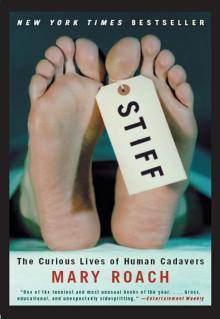 Stiff
Stiff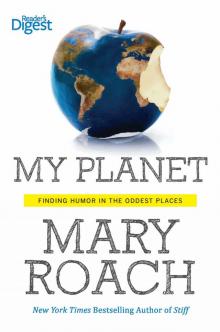 My Planet: Finding Humor in the Oddest Places
My Planet: Finding Humor in the Oddest Places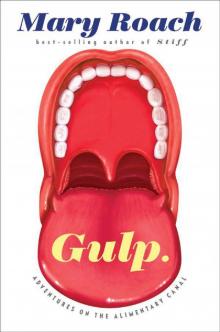 Gulp: Adventures on the Alimentary Canal
Gulp: Adventures on the Alimentary Canal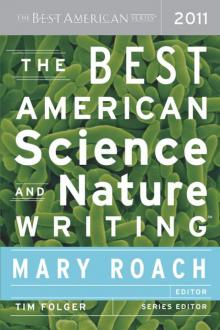 The Best American Science and Nature Writing 2011
The Best American Science and Nature Writing 2011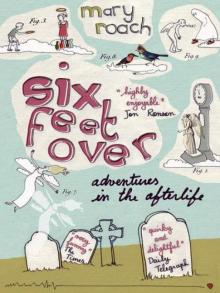 Six Feet Over: Adventures in the Afterlife
Six Feet Over: Adventures in the Afterlife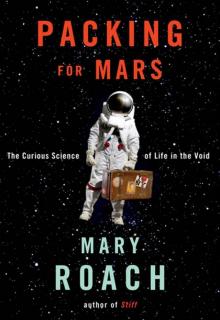 Packing for Mars: The Curious Science of Life in the Void
Packing for Mars: The Curious Science of Life in the Void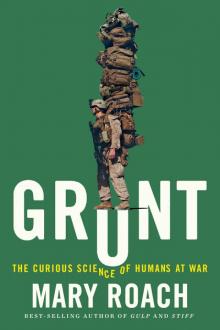 Grunt: The Curious Science of Humans at War
Grunt: The Curious Science of Humans at War